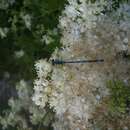Biology
provided by Arkive
Increasingly more is known of the biology of this species as a result of research initiated by the UK southern damselfly Species Action Plan Steering Group (5). Adults can be seen flying between mid-May to August (3), the flight is weak, and they tend to stay level with grasses and other vegetation (6). As with all odonata (dragonflies and damselflies), males and females fly linked together in tandem whilst mating, forming the 'wheel position' (6). When female southern damselflies lay their eggs, they often remain in tandem with the male and drag him below water where the eggs are laid on submerged or emergent vegetation (5). The larvae, which are voracious predators, hatch soon after the eggs are laid, but development to the adult stage takes 2 years (6).
Conservation
provided by Arkive
The UK population of the southern damselfly is of international importance. The species was highlighted as a priority for conservation by the UK Biodiversity Action Plan (UK BAP). The Species Action Plan has three main aims: to ensure that all UK populations are in favourable condition, to maintain the 1995 UK range preventing further loss of sites in England and Wales, and to increase the 1995 range by encouraging re-establishment of 5 former sites in 2005 (4). A steering group was formed to co-ordinate the conservation of this species; this includes the Environment Agency, The Wildlife Trusts, English Nature, Countryside Council for Wales, the British Dragonfly Society and Liverpool University (3).
Description
provided by Arkive
Males are sky-blue and black in colour, with blue eyes and two small eyespots. They can be distinguished from the males of similar species by the blue 'mercury mark' on the second segment of the abdomen, but detailed examination of the anal appendages is the only reliable method. Females do not possess these anal 'accessory genitalia' but have an ovipositor, which is not always easily visible (8). Females are generally green or blue and slightly lighter than males in colour, becoming brown as they age. They tend to have similar markings to males on the head and thorax but have darker abdomens. In both sexes the wings are clear with small black marks towards the tips (7).
Habitat
provided by Arkive
The southern damselfly breeds mainly in heathland streams as well as chalk streams and calcareous mires (4).
Range
provided by Arkive
This globally threatened species (4) is found in Western Europe and Northwest Africa, and is mainly centred on the western Mediterranean. In Great Britain it reaches the north-western extreme of its range (3), and is largely restricted to the south west with two strongholds in the New Forest and Pembrokeshire. It is also found in Devon, Dorset, Mid-Glamorgan, Oxfordshire, Hampshire, the Gower Peninsula, and Anglesey (4).
Status
provided by Arkive
Classified as Near Threatened (NT) on the IUCN Red List 2006 (2), and Rare under the GB Red Data Book. Listed under Appendix II of the EC Habitats Directive and Annex II of the Berne Convention (4).
Threats
provided by Arkive
Since 1960 the UK range of this species has decreased by 30% (4). Reasons for this decline include a decrease in grazing levels resulting in a loss of the open habitat needed at breeding sites. Water drainage, dredging and nutrient enrichment from agricultural run-off are also likely to have impacted on this species (3).
Coenagrion mercuriale
provided by wikipedia EN
Coenagrion mercuriale, the southern damselfly, is a species of damselfly in the family Coenagrionidae. It is found in Algeria, Austria, Belgium, France, Germany, Italy, Liechtenstein, Luxembourg, Morocco, the Netherlands, Portugal, Romania, Slovakia, Slovenia, Spain, Switzerland, Tunisia, and the United Kingdom. Its natural habitats are rivers and freshwater springs. It is threatened by habitat loss.
The specific part of the scientific name, mercuriale, is because of the distinctive markings on the second segment of the abdomen that resembles the astrological symbol for the planet Mercury - ☿. [2] This also gives the species an alternative common name of mercury bluet.[3]
Habitat
They require areas of open vegetation, mixed with slow flowing water in which to lay their eggs.
The larvae spend 2 years underwater before emerging as damselflies.
Status in the United Kingdom
It is thought that 25% of the world population exists within the United Kingdom but it has declined by 30% since 1960 due to changes in grazing, land drainage and water abstraction.
Places where they are found include the New Forest, Hampshire, Oxfordshire and the Preseli Hills, Pembrokeshire, where work was being carried out in 2015 to improve habitat,[4] work that was reported in 2020 as successful.[5] In 2009, 500 adults were captured and released in the Venn Ottery nature reserve in Devon. This nature reserve is owned and managed by the Devon Wildlife Trust and grazing has been re-introduced there to help encourage this species which had not been recorded there since 1988.[6]
The species is protected under Schedule 5 of the Wildlife and Countryside Act 1981.[7]
male, Crockford Stream, Hampshire
no spur on S9
male, Crockford Stream, Hampshire
two spurs on S9
Sources

- license
- cc-by-sa-3.0
- copyright
- Wikipedia authors and editors
Coenagrion mercuriale: Brief Summary
provided by wikipedia EN

immature male Parsonage Moor,
Oxfordshire Coenagrion mercuriale, the southern damselfly, is a species of damselfly in the family Coenagrionidae. It is found in Algeria, Austria, Belgium, France, Germany, Italy, Liechtenstein, Luxembourg, Morocco, the Netherlands, Portugal, Romania, Slovakia, Slovenia, Spain, Switzerland, Tunisia, and the United Kingdom. Its natural habitats are rivers and freshwater springs. It is threatened by habitat loss.
The specific part of the scientific name, mercuriale, is because of the distinctive markings on the second segment of the abdomen that resembles the astrological symbol for the planet Mercury - ☿. This also gives the species an alternative common name of mercury bluet.
- license
- cc-by-sa-3.0
- copyright
- Wikipedia authors and editors



 immature male Parsonage Moor, Oxfordshire
immature male Parsonage Moor, Oxfordshire